The Great Sustainable Shifts: The Story of ENSULIB
19 أبريل 2024
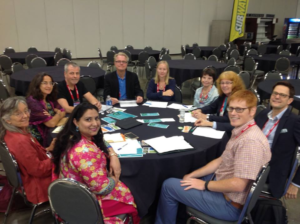
The IFLA Environment, Sustainability and Libraries Section (ENSULIB) has existed little over ten years and the narrative of the group reflects broader shifts in the environmental discussion in libraries. 2010 marked the start of the decade when awareness of environmental sustainability really broke through – from the Paris climate agreement in 2015 to UN Sustainable Development Goals, and the Climate Change Conference (COP26) in Glasgow in 2021. At the same time libraries realized that environmental and social sustainability could and should be at the core of librarianship. However, this awakening has not been the only major shift. The development of library thinking about environmental issues has progressed through green architecture to carbon footprint and even further to carbon handprint. At the same time, the social aspects of sustainability have been recognized in libraries.
ENSULIB was founded in 2009 as a relatively small Special Interest Group. I (Harri) joined the group in 2011 at IFLA WLIC San Juan, Puerto Rico where I delivered a paper. However, I had followed ENSULIB’s open session the previous year in Gothenburg, Sweden. It was that point I realized I wanted to join the group and participate in IFLA.
However, a great deal had happened before that. The driving force behind the formation of ENSULIB was Claudia Lux’s President’s closing address at the IFLA Conference 2008 in Quebec, Canada, in which she addressed for the first time the key role of libraries in the sustainability of the information society.[1] ENSULIB was established next year in IFLA WLIC Milan, Italy, as a Special Interest Group (SIG), sponsored and supported by IFLA’s Preservation and Conservation Section. The group’s original name was Environmental Sustainability and Libraries, and the aim was to contribute to efforts for reaching the UN Millennium Goal 7: Ensure environmental sustainability.[2]
At first, there were only couple of librarians involved in the group, whose first promoter and convener was Veerle Minner from Spain, together with Vincent Bonnet from France.[3] Veerle Minner described the mission, objectives and plans of the ENSULIB in her paper titled “An Agenda for the Environmental Sustainability and Libraries Special Interest Group” (2009).[4] The group grew slowly but steady and gained new, highly motivated members like Petra Hauke (Germany), Philippe Colomb (France), and later on Madeleine Charney (US), Saima Qutab (New Zealand).
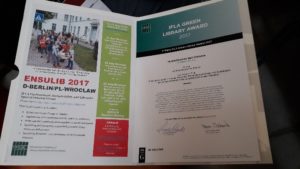
At the end of the decade, the small special interest group worked like a section: WLIC conference sessions were organized every year from 2009 on, including offsite meetings and a Satellite Meeting 2017 in Berlin, Germany. Also, some book projects were completed, and published in the IFLA Publication Series.[5] Last but not least the annual IFLA Green Library Award was first announced in 2016, the announcement for 2022 is currently in progress. Finally, at the IFLA Conference in Kuala Lumpur, Malaysia, the ENSULIB Special Interest Group was awarded as “Runner-up” in the “IFLA Dynamic Unit and Impact Award 2018” competition. After many attempts and efforts, the Professional Committee was finally persuaded to pave the way for the transition from a Special Interest Group to a full-fledged IFLA Section from 2021 on.
As noted above, I joined the group couple of years after it has been established. The reason was simple: many Finnish librarians participated the Gothenburg WLIC conference 2010 since we were preparing for WLIC 2012 in Helsinki, Finland. I was interested in environmental issues and, I thought I was ready to have a paper in the WLIC the following year.[6] At first, I was fascinated but also a bit confused. In the beginning, I recall that I was wondering why the focus was solely on architecture and on green library buildings. I came from a relatively small Finnish public library and felt quite helpless. I realized that I could not do much for the energy efficiency of the building nor did my budget give room for new lighting system or ventilation. It seemed that we could only sort our wastes and recirculate our deaccessioned books. That was not enough for me; I wished to do more. Hence, my argument that we cannot rebuild all the libraries but must learn to run them in environmentally sustainable manner.
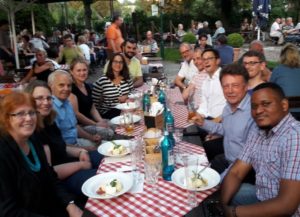
During the last ten years, this way of thinking has become increasingly popular in general environmental discussions and also in libraries. With some hindsight, one might say that around 2010 only carbon footprint was considered. Libraries and other organizations attempted to reduce (energy) consumption and decrease their emissions. This is naturally the foundation for all environmental work, but is only the first step. Subsequently, the concept of carbon handprint was introduced and libraries began to scrutinize the environmental aspects of their services. It was recognised that libraries can reduce their clients’ emissions and need to consume by offering shared spaces and devices. This means that (even small) libraries can have a real role in sustainable communities and a concrete task in environmental work.[7]
The shift of focus from carbon footprint to carbon handprint is remarkable but it is not the only shift which has occurred over the years. Another development has been the rise to prominence of the social aspect of sustainability. This may be illustrated by the first IFLA Green Library Award winner from 2016: El Pequeño Sol Ecological Library (The Little Sun Ecological Library), Mexico.[8] In this project, the inhabitants of a little Mexican village collected recyclable materials from which they built a library for children. The building process was sustainable but so was the over-all goal: to promote children’s literacy since that is an important foundation for environmental sustainability. Sustainability was understood in a broad sense and penetrated the entire process.
This broadening of the sustainability concept also led us to change the group’s name. Originally, the group was called Environmental Sustainability and Libraries. Now, we wished to preserve the “environmental aspect” but also incorporate social and economic sustainability.
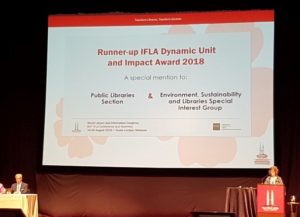
But let us return to the IFLA Green Library Award. The Award has been a great achievement for ENSULIB. It was originally Petra Hauke’s initiative and has become a success. In my mind, two things have been amazing. First, many people have volunteered to work on the Award; over the years about 30 reviewers from all over the world have participated in the jury and evaluated the submissions. Second, there have been so many submissions (again) from all over the world that in 2021 we needed to do some preliminary elimination and the Award had to be divided into two categories: Best Green Library and the Best Green Library Project. The further development of the Award is on ENSULIB’s Action plan for 2021–2023 and a working group has been formed to formulate revised definitions of green and sustainable libraries, clear descriptions of the new categories and robust criteria for the Award. With these actions ENSULIB wishes to enhance the significance of IFLA Green Library Award.
The IFLA Green Library Award was originally conceived of by a small Special Interest Group. This situation changed dramatically at the beginning of 2021 when ENSULIB gained section status and now has a full standing committee of 20 members. The standing committee begun its work at the IFLA WLIC 2021, in August – and hence, we are still organizing our working methods, but it is evident that in future ENSULIB will be stronger and more proactive in the united library field that is interested in environmental issues. I cannot describe how happy we are about the transition – we had been working hard for it for several years.
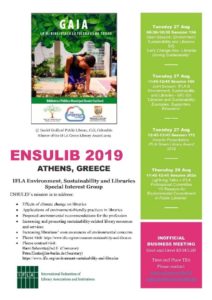
ENSULIB’s transition from SIG to section reflects another great shift in societal thinking about environmental sustainability. States, but also cities, local communities, and organizations, have committed to various environmental agreements, programmes, and goals. The most remarkable of these are Paris Climate Agreement carbon neutrality goals, and UN Agenda 2030. Environmental issues are in focus everywhere in society. For libraries this means two things. First, libraries are not alone in their environmental work anymore. As a chief librarian, I and my library’s property management team have now the same carbon neutrality goals and we work together to attain them. Environmental requirements are considered seriously. The second point is that the new goals — especially UN Sustainable Development Goals — have broadened our thinking about sustainable libraries. Libraries must now re-examine their environmental work though the 17 SDGs. In a way, this may seem like an easy job since libraries can always claim that they offer information on several topics — for example, life under water and life on earth (goals 14 and 15). It is also relatively easy to find the central goals of libraries – libraries strive for good education and to reduce inequalities (goals 4 and 10). However, it is harder to say how libraries really and concretely advocate these goals and how to measure or otherwise show that the positive results are delivered. It seems evident that this kind of criterion will be added to the IFLA Green Library Award 2022 criteria. Considering all of these things, it is evident there is still a lot for ENSULIB to do.
Written by Harri Sahavirta, December 2021
[1] Lux, Claudia (2008). World Library and Information Congress, Québec, 2008: Opening address by the President of IFLA. IFLA Journal, 34 (4), 333–336.
[2] United Nations (n.d.). Millennium Development Goals: Goal 7: Ensure Environmental Sustainability.
[3] Bonnet, Vincent (2009). How green is my library? Exploring Sustainability and Libraries in a Global World.
[4] Minner Van Neygen, Veerle (2009). An Agenda for the Environmental Sustainability and Libraries Special Interest Group. Paper submitted for the 75th World Library and Information Congress, 23–27 August 2009, Milan, Italy. https://www.ifla.org/past-wlic/2009/168-minner-en.pdf
[5] Hauke, Petra; Latimer, Karen; Niess, Robert (eds.) (2021). New Libraries in Old Buildings: Creative Reuse. (IFLA Publication, 180). Berlin and Boston: De Gruyter Saur. ISBN: 978311067951-9. https://www.ibi.hu-berlin.de/de/studium/studprojekte/buchidee/bi19-20/startseite
Hauke, Petra; Charney, Madeleine; Sahavirta, Harri (eds.) (2018). Going Green: Implementing Sustainable Strategies in Libraries Around the World: Buildings, Management, Programmes and Services. (IFLA Publication, 177). Berlin and Boston: De Gruyter Saur. ISBN: 9783110608878. https://www.ibi.hu-berlin.de/de/studium/studprojekte/buchidee/bi17s/bi17s%20en
Hauke, Petra; Latimer, Karen; Werner, Klaus Ulrich (eds.) (2013). The Green Library -– Die grüne Bibliothek: The Challenge of Environmental Sustainability – Ökologische Nachhaltigkeit in der Praxis. (IFLA Publication, 161). Berlin and Boston: De Gruyter Saur. ISBN: 978-3-11-030927-0 https://www.ibi.hu-berlin.de/de/studium/studprojekte/buchidee/bi12
[6] Sahavirta, Harri (2012). Showing the Green Way – Advocating Green Values and Image in a Finnish Public Library. IFLA Journal, 38 (2), 239–242.
[7] Sahavirta, Harri (2012). A visit to the library reduces your carbon footprint: The library, pioneer in environmental sustainability. In Sonkkanen, Leila; Minna Asikainen, Harri Sahavirta (eds.), Green@library (pp. 14–19).
[8] Germinalia (2016). Pequeño Sol Green Library.